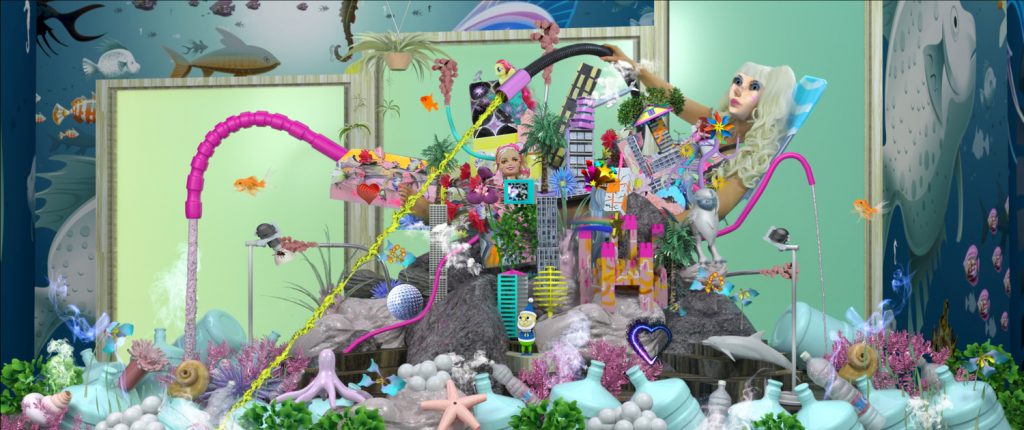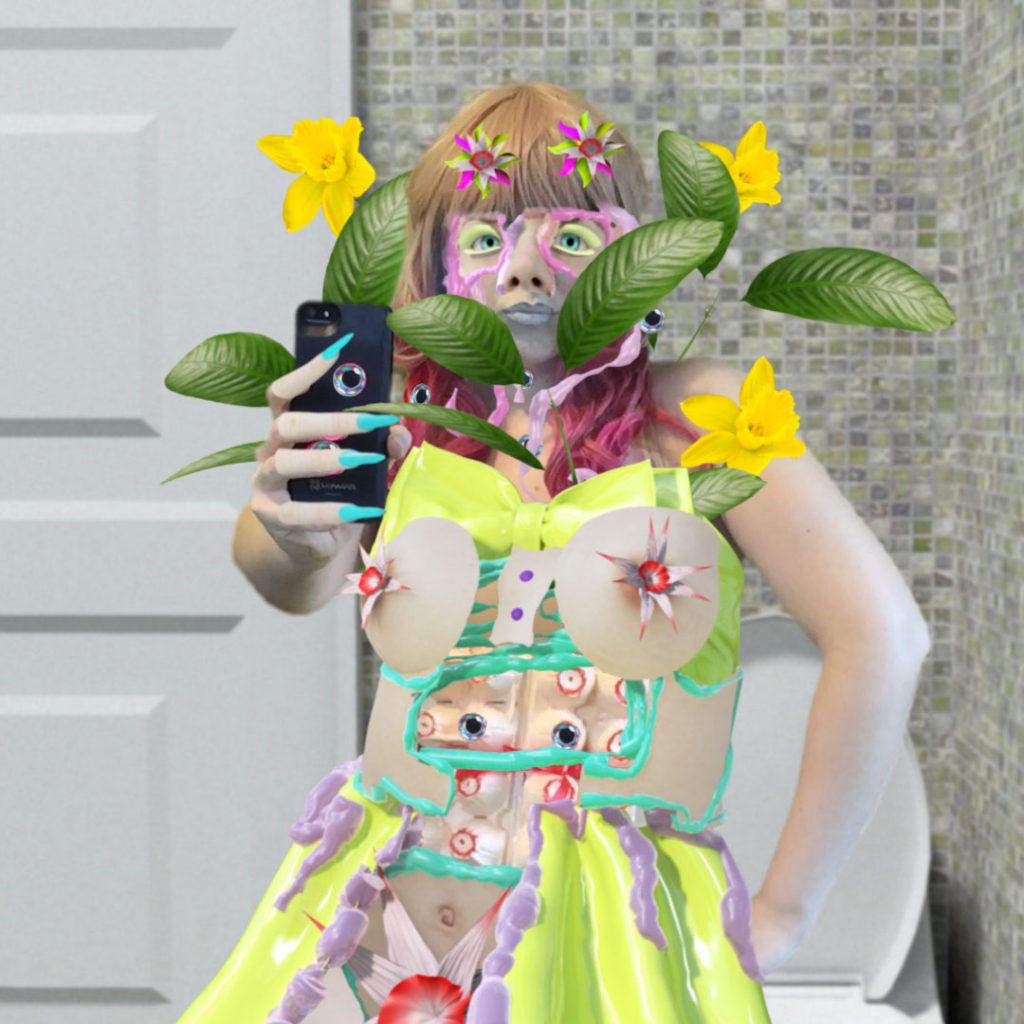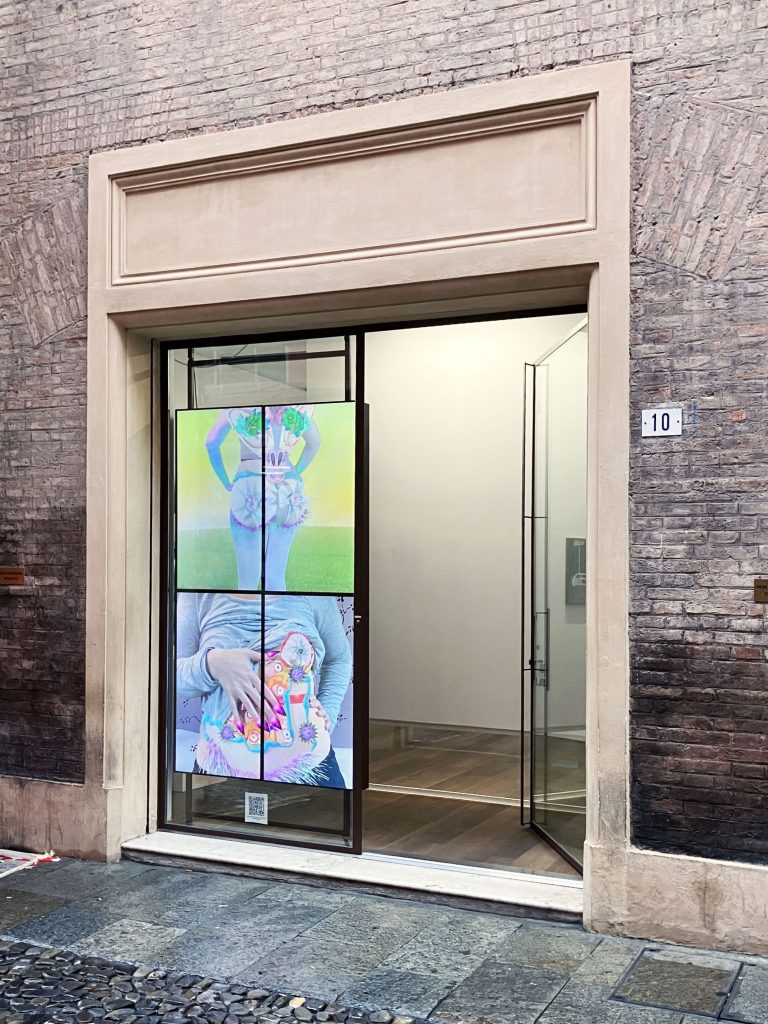KATIE TORN
Generazione Critica: Your visual practice is a patchwork of different visual elements, digital and analogue, forming complex tableaux vivants. Can you tell us how it has evolved over the years?
Katie Torn: I started off as a painter who wanted to be a filmmaker. As an undergraduate student I took a video art class that made me realize that I could use elements of moving image, within a more studio based art practice. I began building sculptures as sets, video taping them, and manipulating them with simple computer effects. As a graduate student I was introduced to 3D animation by the artist Claudia Hart, who had developed a number of courses that used computer graphics and effects to make “virtual sculpture” and “virtual performance”. It was exactly what I was looking for because you are literally moving virtual lights and cameras around like a filmmaker, but the process is more meditative, you can do it alone and make visual decisions about composition, light and form much like a painter. My style emerged from trying to mash the virtual and the physical together to create worlds where the virtual is more tangible and the physical is imaginary.
GC: In your artistic oeuvre, it is also possible to detect references to other experiences and trends: for instance, some of the pictures reminded me of Fornasetti’s illustrations, but it is also possible to discern hints of Surrealism, manga, as well as a critique of consumerism. What are and were your references?
KT: I love Fornasetti’s work! I definitely relate to the idea of combining the female form into design elements. I studied classical painting as a teenager and spent hours in the Metropolitan Museum of Art looking at figurative painting. I was always drawn to Surrealism. I especially like Max Ernst and Yves Tanguy. Ernst is great with the grotesque, combining natural and synthetic forms, animal and human. The spaces and forms that Tanguy creates in his paintings reminds me of the endless virtual space in a 3D computer software. I reference 20th century art in my work but I also reference my experience growing up bombarded by American consumer culture. My creative experience as a child was influenced by the shows and toys I played with. I like to experiment with the aesthetic of Disney and My Little Pony, but use it in a way that creates images that can be interpreted as off putting. I think manga and anime combine cute and grotesque really well.

Katie Torn, Beanie Baby NFT series
GC: In @RealLifeCindy you examine your body and your persona through a series of filters that transform your face and body by adding vegetal details such as flowers, plants, wings, exotic fruits, in an almost carnivalesque portrait that is very reminiscent of the decompositions of cubist subjects. In this series you experiment with different personalities in front of the camera, just like when we play with Instagram filters. How did the work come about?
KT: You are spot on about the cubist reference. I made @RealLifeCindy after I made another piece called Breath Deep, where I created a wearable sculpture that I performed in for the camera. I’m interested in the idea of using my body as a sculptural material, which then creates a character that is both human and object. When people use filters on themselves for social media it is also like they are using their bodies as a material to create this other thing that is an imagined version of themselves. They are combining the real and effects to project an image where the viewer is unsure where the illusion starts. With this piece I was poking fun at the troupes you saw on instagram at the time, while also being inspired by their aesthetics.

Katie Torn, Breathe Deep, Video Still
GC: Sociologist Benjamin Bratton defines the User as a ‘plurality of agents’, or rather a ‘position within a system’ that they inhabit, shaping it in their own image, influenced by environmental and social factors. The filters of Instagram and similar platforms give users the ability to distribute themselves through different subjectivities in time and space, they are a tool with which to shape our image. How does this relate to your work?
KT: I think it relates to this idea that you can use certain defining features that you have to signify that it is you but can take those features and use tools to manipulate them to project a “better” self that fits into whatever community you are aspiring to be part of online. In this project I’m exaggerating this idea so that it becomes almost comical.
GC: In the description of the work @RealSelfCindy, you state that @RealSelfCindy performs in front of a camera connected to a social network to examine her body to discover her true self. Who is @RealSelfCindy and what is her real self?
KT: @RealSelfCindy is a persona, she is an alter ego. Her real self is what her mind wants her to be, unbound by the limits of her actual physical form.

Katie Torn, @RealLifeCindy, Video Still
GC: In the Digital Video Wall, @RealLifeCindy is visually organized in a specific way. The upper portion is occupied by the large image of yourself, while the lower portion is occupied by the overall image. Would you tell us about this aesthetic choice in relation to the vertical orientation of the Video Wall?
KT: I enjoyed the challenge of having to adapt the piece to the format of the video wall. It reminded me of playing the surrealist game exquisite corpse and I liked the idea of viewing the wall as one body composed of two separate images.
GC: In his PhD dissertation, published in the book Arte e Social Media. Generatori di sentimenti (2022), Kamilia Kard calls those tools in the digital world that help us convey sensations and feelings “generators of feelings”, and she includes filters among them. In her investigation, Kard attributes to the user the willingness to passively accept the algorithmic manipulation of our feelings, as she states, but at the same time there is an active role as well, which gives the user the will to use these tools as a means of expression. I find this duality interesting, passivity and active manipulation that makes us passive spectators of disparate modes of self-presentation and creators of digital content. What do you think?
KT: I think it’s very cyborgian. As users we are organic feeling beings, but we communicate through unfeeling machine interfaces that organize millions of thoughts and feelings into something more simplified that we can understand and consume and then respond to in an emotional way. We are allowed space to be individual but have to express ourselves within the confines of a system. We let it take control with the hope and desire to be understood and deemed important.
GC: In recent months, there has been a lot of talk about the role of artificial intelligence in the production of various types of digital content, and it is often forgotten how its role is actually very influential on how online contents are accessed. The algorithms of platforms such as Instagram and TikTok literally shape our preferences, on the one hand locking us into homogeneous bubbles that present us with extremely similar content, and on the other influencing how we show ourselves. Can you share your point of view in this regard? How would your artistic practice relate to the different artificial intelligence software that is populating our media landscape?
KT: I recently joined TikTok and it was interesting to see what kind of content it threw at me. It tried to tap into certain basic things about me and I found it kind of frightening, but boring. It was interesting to see the algorithm attempting to feed me what it thought I wanted on a very superficial level. I’ve been on Facebook and Instagram for such a long time now and those apps really know me much better and have created more of a feedback loop based on my preferences. I think we’re still at a point with AI where it shows us its flaws and that is reassuring for the time being. I can still usually tell what images are made with AI, It has a particular look to it. I’ve experimented with Stable Diffusion and Dall-E quite a bit to create digital collages from different prompts and I am inspired by some of the results . I want to figure out how to use AI as a material alongside the other digital tools I already use in my practice.
02/03/2023

© Katie Torn, @RealSelfCindy, 2023, DVW Installation View, Metronom IT

